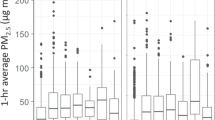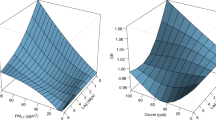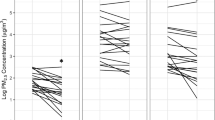Abstract
Background
Exhaled nitric oxide concentration (FENO) is a marker of airway inflammation. This study aimed to evaluate the association of air pollution exposure with FENO levels and asthma prevalence with respiratory symptoms in school children.
Methods
We analyzed 4736 school children who reside in six townships near industrial areas in central Taiwan. We evaluated asthmatic symptoms, FENO, and conducted the environmental questionnaire. The personal exposure of PM2.5, NO, and SO2 was estimated using land-use regression models data on children’s school and home addresses.
Results
Annual exposure to PM2.5 was associated with increased odds of physician-diagnosed asthma (OR = 1.595), exercise-induced wheezing (OR = 1.726), itchy eyes (OR = 1.417), and current nasal problems (OR = 1.334) (P < 0.05). FENO levels in the absence of infection were positively correlated with age, previous wheezing, allergic rhinitis, atopic eczema, near the road, and for children with high exposure to PM2.5 (P < 0.05). An increase of 1 μg/m3 PM2.5 exposure was significantly associated with a 1.0% increase in FENO levels for children after adjusting for potential confounding variables, including exposures to NO and SO2.
Conclusions
Long-term exposures to PM2.5 posed a significant risk of asthma prevalence and airway inflammation in a community-based population of children.
Impact
-
Annual exposure to PM2.5 was associated with increased odds of physician-diagnosed asthma and nasal problems and itchy eyes. Long-term exposures to PM2.5 were significantly associated with FENO levels after adjusting for potential confounding variables.
-
This is first study to assess the association between FENO levels and long-term air pollution exposures in children near coal-based power plants.
-
An increase of 1 μg/m3 annual PM2.5 exposure was significantly associated with a 1.0% increase in FENO levels. Long-term exposures to PM2.5 posed a significant risk of asthma prevalence and airway inflammation in a community-based population of children.
This is a preview of subscription content, access via your institution
Access options
Subscribe to this journal
Receive 14 print issues and online access
$259.00 per year
only $18.50 per issue
Buy this article
- Purchase on Springer Link
- Instant access to full article PDF
Prices may be subject to local taxes which are calculated during checkout

Similar content being viewed by others
Data availability
The datasets generated during the current study are available from the corresponding author upon reasonable request and with permission of Changhua County Ministry of Health and institutional review board (Changhua Christian Hospital IRB).
References
Ma, X., Longley, I., Gao, J. & Salmond, J. Assessing school children’s exposure to air pollution during the daily commute—a systematic review. Sci. Total Environ. 737, 140389 (2020).
Murrison, L. B., Brandt, E. B., Myers, J. B. & Hershey, G. K. K. Environmental exposures and mechanisms in allergy and asthma development. J. Clin. Investig. 129, 1504–1515 (2019).
Pawankar, R. et al. Asia Pacific Association of Allergy Asthma and Clinical Immunology White Paper 2020 on climate change, air pollution, and biodiversity in Asia-Pacific and impact on allergic diseases. Asia Pac. Allergy 10, e11 (2020).
Poole, J. A. et al. Impact of weather and climate change with indoor and outdoor air quality in asthma: a work group report of the AAAAI Environmental Exposure and Respiratory Health Committee. J. Allergy Clin. Immunol. 143, 1702–1710 (2019).
Houdouin, V. & Dubus, J. C. What is the impact of outdoor pollution on children’s asthma? Arch. Pediatr. 26, 487–491 (2019).
Aguilera, R., Corringham, T., Gershunov, A., Leibel, S. & Benmarhnia, T. Fine particles in wildfire smoke and pediatric respiratory health in California. Pediatrics 147, e2020027128 (2021).
Payne-Sturges, D. C. et al. Healthy air, healthy brains: advancing air pollution policy to protect children’s health. Am. J. Public Health 109, 550–554 (2019).
Oliveira, M., Slezakova, K., Delerue-Matos, C., Pereira, M. C. & Morais, S. Children environmental exposure to particulate matter and polycyclic aromatic hydrocarbons and biomonitoring in school environments: A review on indoor and outdoor exposure levels, major sources and health impacts. Environ. Int. 124, 180–204 (2019).
McGeachie, M. J. et al. Patterns of growth and decline in lung function in persistent childhood asthma. N. Engl. J. Med. 374, 1842–1852 (2016).
Jung, C. R., Chen, W. T., Tang, Y. H. & Hwang, B. F. Fine particulate matter exposure during pregnancy and infancy and incident asthma. J. Allergy Clin. Immunol. 143, 2254–2262 (2019).
Guo, C. et al. Long-term exposure to ambient fine particulate matter (PM2.5) and lung function in children, adolescents, and young adults: a longitudinal cohort study. Environ. Health Perspect. 127, 127008 (2019).
Chen, B. Y. et al. Changes in the relationship between childhood asthma and ambient air pollution in Taiwan: Results from a nationwide survey repeated 5 years apart. Pediatr. Allergy Immunol. 30, 188–194 (2019).
Schultz, E. S., Litonjua, A. A. & Melén, E. Effects of long-term exposure to traffic-related air pollution on lung function in children. Curr. Allergy Asthma Rep. 17, 41 (2017).
Dweik, R. A. et al. American Thoracic Society Committee on interpretation of exhaled nitric oxide levels for clinical applications. An official ATS clinical practice guideline: interpretation of exhaled nitric oxide levels (FENO) for clinical applications. Am. J. Respir. Crit. Care Med. 184, 602–615 (2011).
Wen, Y. S. et al. Nasal nitric oxide is a useful biomarker for acute unilateral maxillary sinusitis in pediatric allergic rhinitis: a prospective observational cohort study. World Allergy Organ. J. 12, 100027 (2019).
Chien, J. W. et al. Increased IL-17A secreting CD4+ T cells, serum IL-17 levels and exhaled nitric oxide are correlated with childhood asthma severity. Clin. Exp. Allergy 43, 1018–1026 (2013).
Tsai, Y. G. et al. High exhaled nitric oxide levels correlate with nonadherence in acute asthmatic children. Ann. Allergy Asthma Immunol. 118, 521–523 (2017).
Tsai, Y. G. et al. A single dose of nebulized budesonide decreases exhaled nitric oxide in children with acute asthma. J. Pediatr. 139, 433–437 (2001).
Petsky, H. L., Kew, K. M. & Chang, A. B. Exhaled nitric oxide levels to guide treatment for children with asthma. Cochrane Database Syst. Rev. 11, CD011439 (2016).
Annesi-Maesano, I. & Dinh-Xuan, A. T. Is exhaled nitric oxide a marker of air pollution effect? Eur. Respir. J. 47, 1304–1306 (2016).
Olaniyan, T. et al. The association between ambient NO2 and PM2.5 with the respiratory health of school children residing in informal settlements: a prospective cohort study. Environ. Res. 186, 109606 (2020).
Berhane, K. et al. Longitudinal effects of air pollution on exhaled nitric oxide: the Children’s health study. Occup. Environ. Med. 71, 507–513 (2014).
Berhane, K. et al. The effect of ambient air pollution on exhaled nitric oxide in the Children’s health study. Eur. Respir. J. 37, 1029–1036 (2011).
Salam, M. T. et al. Genetic and epigenetic variations in inducible nitric oxide synthase promoter, particulate pollution, and exhaled nitric oxide levels in children. J. Allergy Clin. Immunol. 129, 232–239 (2012).
Chen, X. et al. The association between short-term exposure to ambient air pollution and fractional exhaled nitric oxide level: A systematic review and meta-analysis of panel studies. Environ. Pollut. 265, 114833 (2020).
Lin, L. M. et al. Small airway dysfunction measured by impulse oscillometry and fractional exhaled nitric oxide is associated with asthma control in children. Front Pediatr. 10, 877681 (2022).
Lee, Y. L., Hwang, B. F., Lin, Y. C. & Guo, Y. L., Taiwan Childhood Allergy Survey Group. Time trend of asthma prevalence among school children in Taiwan. Pediatr. Allergy Immunol. 18, 188–195 (2007).
Beelen, R. et al. Effects of long-term exposure to air pollution on natural-cause mortality: an analysis of 22 European cohorts within the multicentre ESCAPE project. Lancet 383, 785–795 (2014).
Chio, C. P. et al. Health impact assessment of PM2.5 from a planned coal-fired power plant in Taiwan. J. Formos. Med. Assoc. 118, 1494–1503 (2019).
Zhang, Y. et al. Genetic and epigenetic susceptibility of airway inflammation to PM2.5 in school children: new insights from quantile regression. Environ. Health 16, 88 (2017).
Carlsen, H. K., Boman, P., Björ, B., Olin, A. C. & Forsberg, B. Coarse fraction particle matter and exhaled nitric oxide in non-asthmatic children. Int. J. Environ. Res. Public Health 13, 621 (2016).
Eckel, S. P. et al. Residential traffic-related pollution exposures and exhaled nitric oxide in the children’s health study. Environ. Health Perspect. 119, 1472–1477 (2011).
Flamant-Hulin, M., Caillaud, D., Sacco, P., Penard-Morand, C. & Annesi-Maesanoet, I. Air pollution and increased levels of fractional exhaled nitric oxide in children with no history of airway damage. J. Toxicol. Environ. Health A. 73, 272–283 (2010).
Dales, R. et al. The influence of living near roadways on spirometry and exhaled nitric oxide in elementary schoolchildren. Environ. Health Perspect. 116, 1423–1427 (2008).
Delfino, R. J. et al. Personal and ambient air pollution is associated with increased exhaled nitric oxide in children with asthma. Environ. Health Perspect. 114, 1736–1743 (2006).
Salam, M. T., Lin, P. C., Eckel, S. P., Gauderman, W. J. & Gilliland, F. D. Inducible nitric oxide synthase promoter haplotypes and residential traffic-related air pollution jointly influence exhaled nitric oxide level in children. PLoS One 10, e0145363 (2015).
Amster, E. & Levy, C. L. Impact of coal-fired power plant emissions on children’s health: a systematic review of the epidemiological literature. Int. J. Environ. Res. Public Health 16, 2008 (2019).
Amster, E. Public health impact of coal-fired power plants: a critical systematic review of the epidemiological literature. Int. J. Environ. Health Res. 31, 558–580 (2021).
Amster, E. D., Haim, M., Dubnov, J. & Broday, D. M. Contribution of nitrogen oxide and sulfur dioxide exposure from power plant emissions on respiratory symptom and disease prevalence. Environ. Pollut. 186, 20–28 (2014).
Yogev-Baggio, T. et al. Who is affected more by air pollution-sick or healthy? Some evidence from a health survey of schoolchildren living in the vicinity of a coal-fired power plant in Northern Israel. Health Place 16, 399–408 (2010).
Peled, R. et al. Fine particles and meteorological conditions are associated with lung function in children with asthma living near two power plants. Public Health 119, 418–425 (2005).
Lin, W. et al. Acute respiratory inflammation in children and black carbon in ambient air before and during the 2008 Beijing Olympics. Environ. Health Perspect. 119, 1507e12 (2011).
Adar, S. D., D’Souza, J., Sheppard, L., Kaufman, J. D. & Hallstrand, T. S. Adopting clean fuels and technologies on school buses. pollution and health impacts in children. Am. J. Respir. Crit. Care Med. 191, 1413–1421 (2015).
Cui, X. et al. Association between bedroom particulate matter filtration and changes in airway pathophysiology in children with asthma. JAMA Pediatr. 174, 533–542 (2020).
Zhang, Y. et al. Long-term exposures to air pollutants affect FeNO in children: a longitudinal study. Eur. Respir. J. 58, 2100705 (2021).
Pai, S. J., Carter, T. S., Heald, C. L. & Kroll, J. H. Updated world health organization air quality guidelines highlight the importance of non-anthropogenic PM2.5. Environ. Sci. Technol. Lett. 9, 501–506 (2022).
Liao, M. F., Liao, M. N., Lin, S. N., Chen, J. Y. & Huang, J. L. Prevalence of allergic diseases of schoolchildren in central Taiwan. From ISAAC surveys 5 years apart. J. Asthma 46, 541–545 (2009).
Acknowledgements
We are thanks to Drs: Kao JK, Yong SB, and Lee MS for enrolled cases. The authors are grateful to professors Drs: JL Huang, and YL Lee for their agreement with Chinese version of the ISAAC and environmental questionnaires in the survey. We are grateful to the school principals, teachers, students and parents in each township for their cooperation and especially to the members of the health testing field team for their efforts. This paper was financially supported by the ‘Innovation and Policy Center for Population Health and Sustainable Environment (Population Health Research Center, PHRC), College of Public Health, National Taiwan University’ from The Featured Areas Research Center Program within the framework of the Higher Education Sprout Project by the Ministry of Education (MOE) in Taiwan.
Funding
This study was supported by the Ministry of Science and Technology (grant number NSTC 112-2314-B-371-006 & MOST 111-2314-B-371-006 & 106-2314-B-371-008 & 109-2634-F-002-044), and Featured Areas Research Center Program within the framework of the Higher Education Sprout Project by the Ministry of Education (MOE) in Taiwan (grant number NTU-109L9003), Changhua Christian Hospital (111-CCH-IRP-018; 111-CCH-MST-134, 110-CCH-ICO-152, 112-CCH-ICO-152, 112-CCH-IRP-022) and National Health Research Institutes (EO-110-PP-10), and Academia Sinica, Taiwan (AS-SS-111-02-1).
Author information
Authors and Affiliations
Contributions
C.-P.C., K.D.Y., C.-H.L., Y.-P.Y., and J.-W.C. conceptualized and designed the study and collected the data. Y.-G.T., Y.-J.C. and S.-L.W. analyzed the data and drafted the manuscript. S.-K.H. and C.-C.C. revised it critically for important intellectual content. All authors approved the final manuscript as submitted and agree to be accountable for all aspects of the work.
Corresponding authors
Ethics declarations
Competing interests
The authors declare no competing interests.
Additional information
Publisher’s note Springer Nature remains neutral with regard to jurisdictional claims in published maps and institutional affiliations.
Supplementary information
Rights and permissions
Springer Nature or its licensor (e.g. a society or other partner) holds exclusive rights to this article under a publishing agreement with the author(s) or other rightsholder(s); author self-archiving of the accepted manuscript version of this article is solely governed by the terms of such publishing agreement and applicable law.
About this article
Cite this article
Tsai, YG., Chio, CP., Yang, K.D. et al. Long-term PM2.5 exposure is associated with asthma prevalence and exhaled nitric oxide levels in children. Pediatr Res (2024). https://doi.org/10.1038/s41390-023-02977-5
Received:
Revised:
Accepted:
Published:
DOI: https://doi.org/10.1038/s41390-023-02977-5



